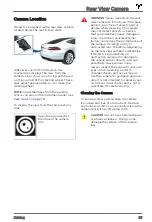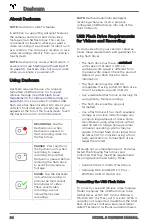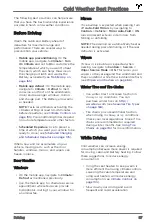
Model S as needed to maintain a chosen
following distance (see
), up to the set speed.
Traffic-Aware Cruise Control also adjusts the
cruising speed when entering and exiting
curves.
You can manually accelerate at any time when
cruising at a set speed, but when you release
the accelerator, Traffic-Aware Cruise Control
resumes cruising at the set speed.
NOTE:
When Traffic-Aware Cruise Control is
actively slowing down Model S to maintain
the selected distance from the vehicle ahead,
brake lights turn on to alert other road users
that you are slowing down. You may notice
slight movement of the brake pedal. However,
when Traffic-Aware Cruise Control is
accelerating Model S, the accelerator pedal
does not move.
WARNING:
Traffic-Aware Cruise
Control may occasionally cause
Model S to brake when not required or
when you are not expecting it. This
can be caused by closely following a
vehicle ahead, detecting vehicles or
objects in adjacent lanes (especially
on curves), etc.
WARNING:
Due to limitations inherent
in the onboard GPS (Global
Positioning System), you may
experience situations in which Traffic-
Aware Cruise Control slows down the
vehicle, especially near highway exits
where a curve is detected and/or you
are actively navigating to a destination
and not following the route.
WARNING:
Traffic-Aware Cruise
Control cannot detect all objects and,
especially in situations when you are
driving over 80 km/h, may not brake/
decelerate when a vehicle or object is
only partially in the driving lane or
when a vehicle you are following
moves out of your driving path and a
stationary or slow-moving vehicle or
object is in front of you. Always pay
attention to the road ahead and stay
prepared to take immediate corrective
action. Depending on Traffic-Aware
Cruise Control to avoid a collision can
result in serious injury or death. In
addition, Traffic-Aware Cruise Control
may react to vehicles or objects that
either do not exist or are not in the
lane of travel, causing Model S to slow
down unnecessarily or inappropriately.
WARNING:
Traffic-Aware Cruise
Control may be unable to provide
adequate speed control because of
limited braking capability and hills. It
can also misjudge the distance from a
vehicle ahead. Driving downhill can
increase driving speed, causing
Model S to exceed your set speed
(and potentially the road's speed
limit). Never depend on Traffic-Aware
Cruise Control to slow down the
vehicle enough to prevent a collision.
Always keep your eyes on the road
when driving and be prepared to take
corrective action as needed.
Depending on Traffic-Aware Cruise
Control to slow the vehicle down
enough to prevent a collision can
result in serious injury or death.
Passing Vehicles in Non-Passing
Lanes
If traveling 80 km/h or faster, Traffic-Aware
Cruise Control requires that you be in a
passing lane in order to pass a vehicle. If you
are in a non-passing lane (to the right of a
vehicle in right-hand traffic, or to the left of a
vehicle in left-hand traffic), Traffic-Aware
Cruise Control prevents you from passing
other vehicles. Instead, Model S slows down
to match the vehicle’s speed as if it were in
the same lane as your vehicle. If you press the
accelerator pedal to pass the vehicle, Traffic-
Aware Cruise Control allows you to pass
vehicles in the non-passing lane until you
Traffic-Aware Cruise Control
94
MODEL S OWNER'S MANUAL
















































